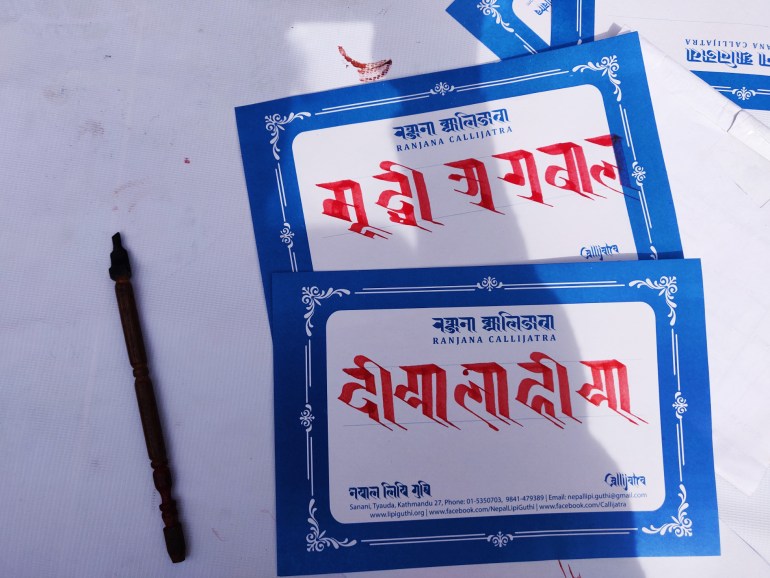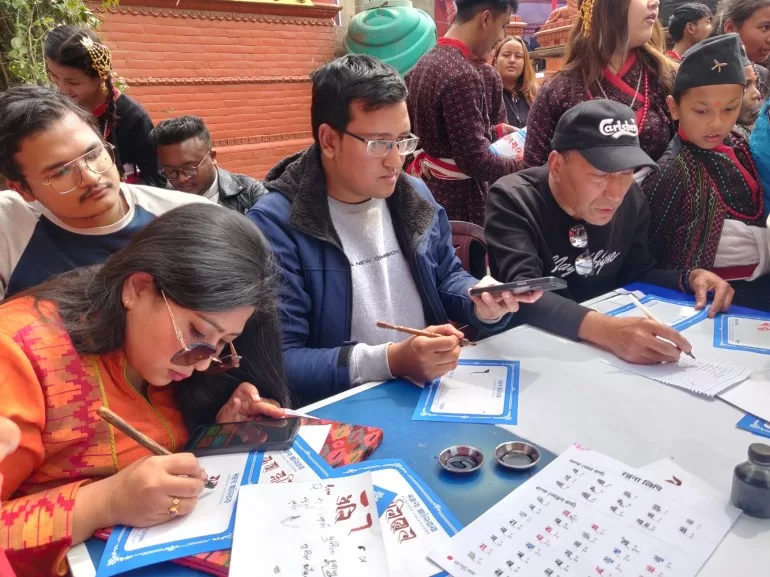Shrestha is here at the open-air Narayani Square in Dhulikhel, a municipality 30km (18 miles) southwest of Nepal’s capital city, Kathmandu, to demonstrate the ancient art of Ranjana calligraphy. She is a member of Callijatra, one of two local organisations working to preserve and promote ancient scripts of Nepal – before they are forgotten.
It’s a warm morning in February and the crowded square is abuzz with the chimes of temple bells and noisy chatter of hundreds of students and adults, mostly dressed in haku patasi (a traditional four-piece black and red ensemble). They’ve come to participate in the annual dhimay jatra – a festival celebrating the dhimay, an ethnic drum of the Newar community, one of Nepal’s Indigenous peoples, with performances and competitions. Deep rhythmic sounds reverberate everywhere.
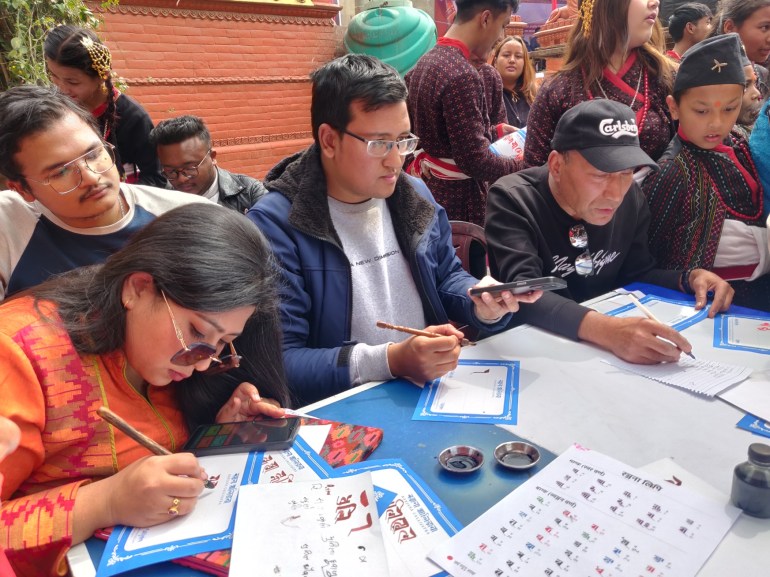
“Jwojalapa (welcome),” says Shrestha, 30, in Nepalbhasa, the language of the Newar community, to the few dozen festival attendees who have gathered at the booth.
Ranjana, which means “delightful” in Sanskrit, “is a joyous script”, Shrestha says, her mouth widening into a grin. She dips her chosa, a bamboo pen, into the earthy brown ink and prepares to write in Ranjana Lipi.
Shrestha pays careful attention to the height, curvature and smoothness of each letter. “The strokes should be evenly placed and match in size,” she says. Writing in Ranjana Lipi is therapeutic, “like meditation”, she adds, “that offers peace of mind”.
First, Jayendra Rajbhandari, 62, a member of Nepal Lipi Guthi, writes my name in red ink. Within minutes, he finishes the most artistic rendering of my name I’ve ever seen.
Among those watching the demo is Rashmi Chhusyabaga, a Newa (from the Newar community) who is eager to see her family’s name in the Ranjana script. “I lack knowledge about Ranjana,” the 22-year-old student says.
Most residents are familiar with the script that abounds in Kathmandu – it appears on signs in public squares, stupas (Buddhist shrines), mahaviharas (Buddhist study centres and residences) and temples – but admit to not knowing how to read and write it.
Ranjana Lipi isn’t taught in schools, and many people are unfamiliar with the script. Callijatra is working to change that.
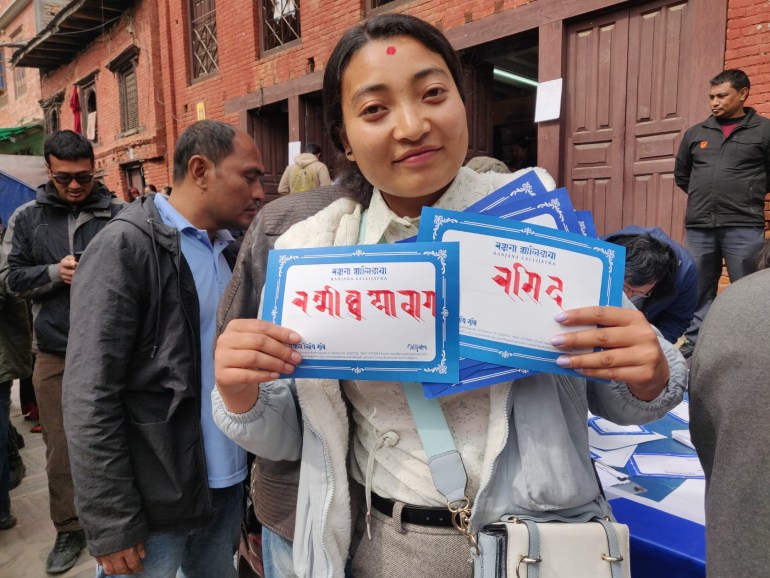
A positive response
Callijatra was started with the goal of preserving two of the nine Nepal scripts: Ranjana Lipi and Nepal Lipi (Prachalit).
The seeds of the organisation were planted in 2017, after font designer Ananda K Maharjan saw a post on Facebook and registered for a 45-day course on Indigenous scripts at Nepal Lipi Guthi, which teaches and promotes Ranjana Lipi and Nepal Lipi.
“Being a Newar, I also wanted to learn and write it,” Maharjan explains. He had searched the internet and libraries for available resources when starting out his journey with Ranjana, but found them “not sufficient”.
After taking the course, he was hooked.
Driven by a new-found desire to create more visibility of Ranjana, Maharjan and three other class attendees – Suyogya Ratna Tamrakar, Bikash Shakya and Sunita Dangol – then organised a calligraphy workshop and demonstration at the Itum Bahal festival, in Kathmandu.
The response, Maharjan says, “was very positive”, with over 50 participants. More than 200 names were written in live calligraphy. No one had conducted a live demonstration of an Indigenous Nepal script on this scale before, he explains.
After the demo, the group received multiple calls and requests to conduct workshops. “Old language experts and Lipi experts were happy and assured that now this script will not die and young people are continuing what they were doing,” Maharjan says.
In 2017, Callijatra was born, with Maharjan as founder and Dangol as the co-founder. The teachers at Nepal Lipi Guthi then “approached Callijatra to join hands”, Maharjan says.
These organisations now work together to structure learning materials, and design courses for workshops and training programmes, regularly conducting over 50 workshops annually. One module can be taught to 100 people at once, says Anil Sthapit, the president of Nepal Lipi Guthi, located in Kathmandu’s Asan neighbourhood.
Sthapit, who also teaches at the institute, points to a colour-coded Ranjana alphabet sheet: “We compare the scripts to the human body,” labelling the alphabet components – chhyan (head), nhipyan (tail), lhaa (hand) and mha (backbone). Letters in red lack a head; green indicates a downward stroke; and blue is “hands up” or upward stroke.
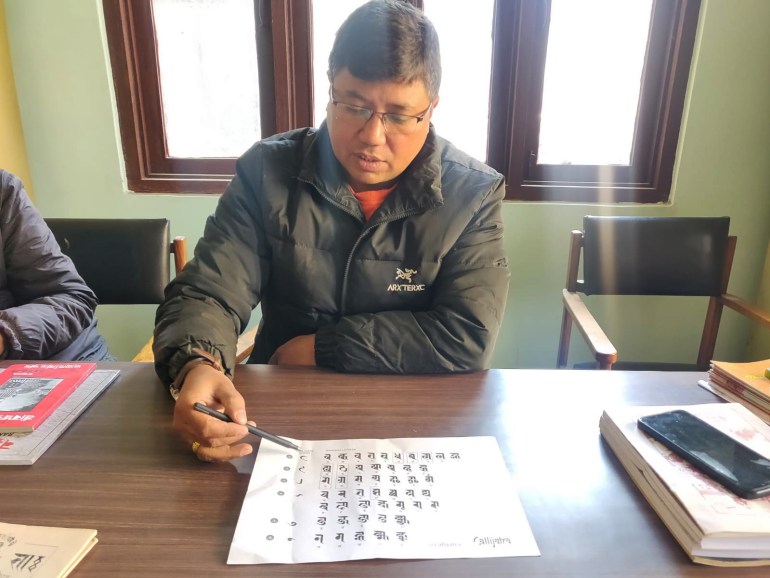
When Callijatra began collaborating with Nepal Lipi Guthi, the latter organisation was several decades old. In 1974, a group of students who had learned Nepal Lipi began teaching Indigenous scripts to preserve ancient knowledge. In 1980, Nepal Lipi Guthi was created to preserve and promote Nepal scripts, literature, culture and art.
Then in 1981, a member brought a manuscript written in Ranjana script to the group. They learned it under the tutelage of Lipi expert Shankar Man Rajbanshi, and began teaching it to more students, helping to spread the knowledge around the city.
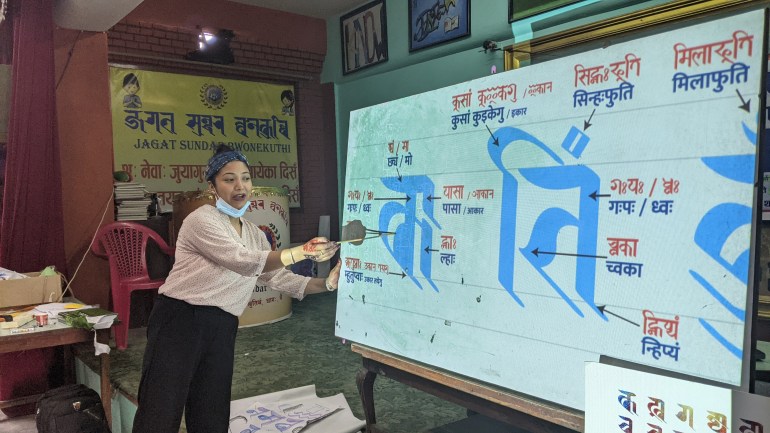
Decline of Nepal scripts
The “Nepal scripts” were used to express different languages: Nepalbhasa, Sanskrit, Maithili, Bhojpuri and Nepali, explains Sarad Kasa, a Nepalbhasa professor at Tribhuvan University in Kathmandu. Their origin is not known, but Kasa says they may have come from the Brahmi script, an ancient Indian writing system, adding that examples of Ranjana Lipi in Tibet exist from the 7th century.
The oldest Ranjana manuscript at the Asa Archives is “a palm leaf from the 14th century”, with a Buddhist sutra (precept or aphorism), Kasa adds.
Books and manuscripts at Kathmandu’s Asa Archives and National Archives of Nepal show that many other ancient scripts – such as Licchavi Lipi, Khema Lipi and Brahmi Lipi – were prevalent in the Licchavi (350-750 AD) and Malla (1200-1769) periods. However, their use fell into decline during the Rana dynasty (1846–1951), which embraced a “one nation-one language” policy intended to promote a strong national identity – one that suppressed languages such as Nepalbhasa and other regional dialects like Hindi and Maithili.
“Learning and writing were banned during the Rana era,” explains Sthapit. Use of Nepal scripts declined when the Rana regime came into power, and were replaced by the Devanagari script, which is still used today.

“A fine of Nepali rupees 100 ($0.75) was imposed” if people were found learning, Sthapit adds, noting “Their property was confiscated by the state.” This instilled fear in the people, “and the tradition of education was lost”, he says.
To prevent books from being seized or burned, many families kept their ancient texts hidden in dhukus (grain storage containers) and puja (worship) rooms where entry was restricted to household members and priests. Nepali scholars went to India and printed books in hiding “to ensure that the knowledge of writing and learning ancient scripts was not completely lost”, Sthapit explains.
Today, students in Kathmandu’s government schools are learning basic Ranjana Lipi, and there are plans to include the script and Nepalbhasa in curricula outside of Kathmandu, Maharjan says.
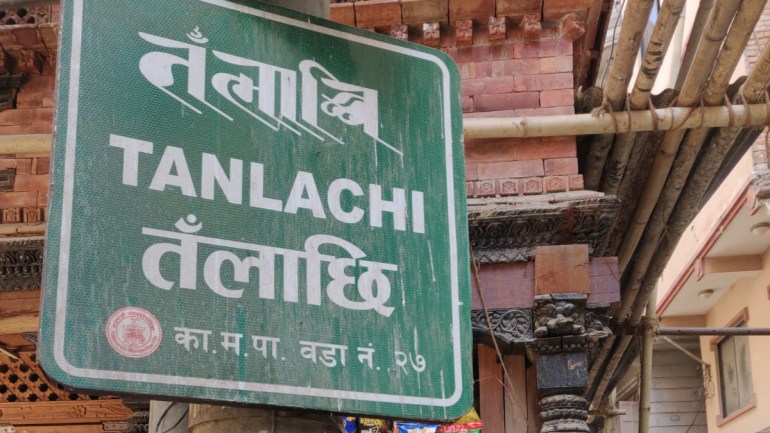
Examples everywhere
After the live demonstration at the Callijatra booth in Dhulikhel, Maharjan meets me on the ground floor of Nepal Lipi Guthi. We walk ahead into the sea-green classroom where he first learned Ranjana Lipi and Nepal Lipi — and where Sthapit was his teacher. The room, which has approximately 25 desks, is full of charts, chalk, chosas and empty ink bottles. The desk chairs are coated in layers of chalk dust.
Then Maharjan gives a tour of the charming old-world Thahiti neighbourhood, not far from the Nepal Lipi Guthi building, wandering down narrow alleys that pass by traditional wooden buildings, looking for signs of the ancient scripts.
At one point he gestures to lettering on the copper-coloured prayer wheels inside a stupa. “The top and the bottom script is Ranjana Lipi,” he explains in a soft voice barely audible amidst honking vehicles in the street.
Across from the stupa, Maharjan spots letters on a temple’s distinctive golden brass pole. “This is a mantra written in Kutakshar [a vertical monogram form of Ranjana script, written vertically from top to bottom],” he explains. Kutakshar was used to write secret mantras and messages, understood only by the writer, he adds.
Examples of Ranjana Lipi have also been found in museum artefacts and heritage sites outside Nepal. “A mantra related to wellbeing is inscribed on the Great Wall of China [Juyongguan section],” explains Sthapit, and in Tibet the script is written on top of entrance gates of houses. A ceremonial helmet from the mid-18th century, displayed at New York’s Metropolitan Museum of Art, features the Buddhist mantra “om mani padme hum” engraved in Ranjana Lipi (Lantsa characters).
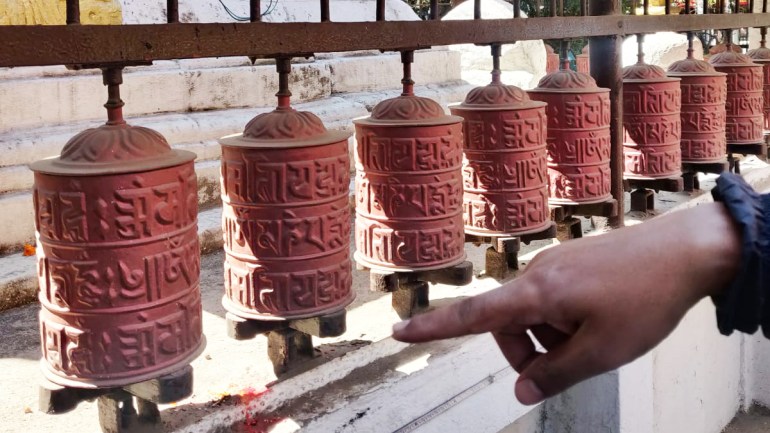
Training new learners
Both Nepal Lipi Guthi and Callijatra work together to teach Nepal’s Indigenous scripts via hundreds of live demonstrations, workshops and presentations.
This year, Callijatra was recognised by the Endangered Alphabets Project on World Endangered Writing Day (January 23) for their revival efforts in training teachers, architects, monks and artists, and creating tutorial videos to assist learners.
“The benefit of training people is to create new art and designs,” Maharjan says quietly, with joy in his voice. These days the script is being used more in wedding invitations, posters, pottery, jewellery, merchandise and art and more. He credits the revival efforts of Callijatra and Nepal Lipi Guthi as well as “youth involvement”.
Sthapit adds that social media has helped promote the scripts worldwide now that “people can produce texts in Ranjana Lipi in their homes.”
There’s also an IOS app called “Nepal Lipi-Ranjana Lipi”, created by Suyogya Ratna Tamrakar, one of the founding Callijatra members, who often gives live demonstrations of Ranjana Lipi.
“I was attracted to Nepal’s traditions and cultures from my childhood,” says Tamrakar, who is now also keen on digital promotion of ancient scripts. Shyly, and with slightly trembling hands, the 30-year-old types “Dhulikhel” in Devanagari script in the app and receives a translation in both Nepal Lipi and Ranjana Lipi. The app, which has more than 100,000 downloads to date, also features educational videos and blogs.
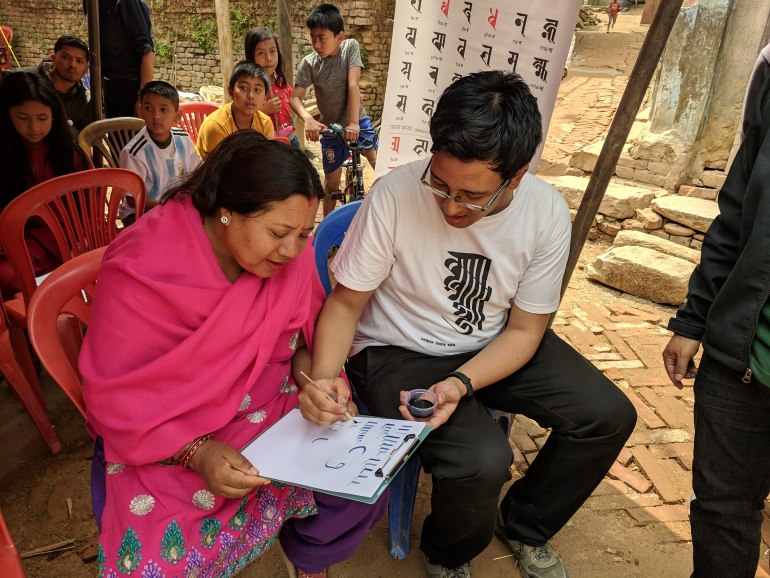
Road ahead
Ranjana Lipi is also gaining prominence across Nepal’s borders, thanks to artists and other passionate promoters of the script.
In February, artwork by Nepali calligrapher Ratan Anand Karna was a popular attraction at the Jaipur International Art and Calligraphy Festival in Hyderabad, India. “Ranjana script is powerful. When you write it, the script draws attention,” Karna says.
In treks across Nepal, he also writes mantras on stones and places them near shrines and stupas. This, he says, “gets noticed by locals who want me to write mantras in Tibetan or Ranjana Lipi”, which are considered sacred and valuable. In April, Karna conducted a week-long course on Ranjana Lipi and Devanagari Lipi for a group of United States students.
Recently, a donation from US-based entrepreneur Murali K Prahalad helped Callijatra to collaborate with Ek Type, a font design studio based in India, to release Nithya Ranjana, a typeface based on Ranjana script.
“All fonts have their limitations, but the Nithya Ranjana font has more conjuncts and compound letters”, which makes it more technically advanced, Maharjan explains.
Callijatra is also looking to teach additional scripts – Bhujimol Lipi, Kirat Lipi, Khema Lipi, Tirhuta [Maithili Lipi] and Licchavi Lipi – via animated courses, games and puzzles for children.
“Research is ongoing,” says Maharjan. Meanwhile, he plans to continue educating students of the “beautiful” scripts, “to teach others in [an] easy and simplified way”.
